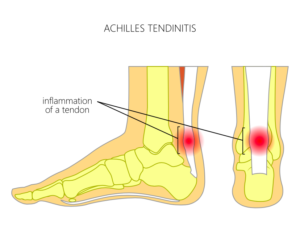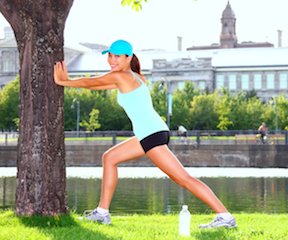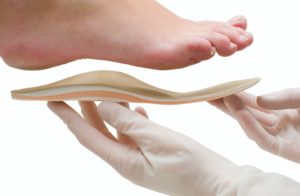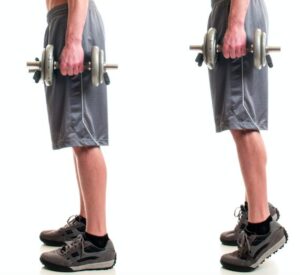アキレス腱炎とは?
アキレス腱炎は繰り返しのランニングなどにより、ふくらはぎの筋肉とかかとの骨を結ぶるアキレス腱に炎症を起こした状態です。
アキレス腱炎があることで走っている時に痛みが出たり、日常の歩行動作でも痛みが出ることがあります。
初期症状としてランニング時の違和感があり、運動中に徐々に痛みが消えていくことがありますが、そのまま運動を続けてしまうと徐々に痛みが悪化していく可能性があります。

アキレス腱炎の痛みは適度な休養を取ることで回復していきますが、アキレス腱炎の根本的な原因から対処していかないとアキレス腱炎を再発してしまうことも珍しくありません。
アキレス腱炎の原因
アキレス腱の強度不足
アキレス腱障害を持っている人達はアキレス腱の強度が低下していたことが報告されています1〜3。
普段から強度の高いトレーニングなどで鍛えていないとアキレス腱は弱くなりやすく、ゆっくりとしたランニングだけではアキレス腱を十分に強くすることは難しいと言われています。

さらにはマラソンを走った後などは炎症などによりアキレス腱の強度が低下してしまう可能性があるので、十分な回復期間を与えることも大切になってきます4。
ランニングフォーム
ランニング動作中のブレーキが強すぎるとアキレス腱炎のリスクが高まることが報告されています5。
ランニングで身体を前に進めようとしている時に、ブレーキをかけるような力が強すぎると余計な負荷がかかってしまうわけです。

アキレス腱炎の改善方法
ストレッチについて
足首の柔軟性の低下はアキレス腱炎のリスクを高める可能性があることが報告されています6。
足首の柔軟性を改善するためのストレッチやケアの方法は比較的シンプルなものも多く、日々のケアに取り入れやすいと言えます。

ヒールクッション
シューズのかかと部分にヒールクッションを置くことで歩行時やランニング時の負荷を減らすことができ、ヒールクッションを処方することでアキレス腱炎の症状が改善することが報告されています7〜9。

ヒールクッションの高さ次第でアキレス腱炎に対する効果が変わってくることが報告されており10・11、ヒールクッションは厚いほどいいとは限らず、最適なクッションは人によって違ってくる可能性があります。
いくつかのヒールクッションを試してみて、最もアキレス腱炎の痛みが楽になるものを選ぶことが賢明であると言えます。
インソール
シューズの調整といえばインソールというくらいに王道の方法ですが、アキレス腱障害を抱えている人にインソールを処方することで痛みが軽減されることが報告されています12。

専門家が処方するインソールは身体のバランスを修正する効果が高く、アキレス腱炎に限らず様々な怪我に対して効果を発揮することが多いです。
ふくらはぎのトレーニング
ただ休養を取るだけよりも、ふくらはぎの筋肉をしっかりと鍛えた方がアキレス腱炎の改善や予防により高い効果を発揮することが報告されています13。
しかし、ふくらはぎのトレーニングはアキレス腱にもある程度の負荷がかかるため、トレーニングのやりすぎで痛みを悪化させないように注意しながら行うことが大切です。

ふくらはぎのトレーニングは腓腹筋が一般的ですが、アキレス腱障害において腓腹筋よりもヒラメ筋のほうが筋力低下が大きいことが報告されています14〜16。
アキレス腱炎の予防のためにはアキレス腱周辺の筋肉をバランス良く鍛えておくことが大事であると言えます。
まとめ
アキレス腱炎は繰り返しのランニングによって発症しますが、アキレス腱の強度の低下やランニングフォーム、身体に合わないランニングシューズといった要素がアキレス腱炎のリスクになります。
アキレス腱炎の痛みにはシューズの調整やテーピング、ふくらはぎのトレーニングでアキレス腱の強度を高めることが役に立ちます。
<参考文献>
Child S, Bryant AL, Clark RA, Crossley KM. Mechanical Properties of the Achilles Tendon Aponeurosis Are Altered in Athletes With Achilles Tendinopathy. Am J Sports Med. 2010;38(9):1885-1893.
Arya S, Kulig K. Tendinopathy alters mechanical and material properties of the Achilles tendon. Journal of Applied Physiology. 2010;108(3):670-675.
- McAuliffe S, McCreesh K, Culloty F, Purtill H, O’Sullivan K. Can ultrasound imaging predict the development of Achilles and patellar tendinopathy? A systematic review and meta-analysis. Br J Sports Med. 2016;50(24):1516-1523. doi:10.1136/bjsports-2016-096288
- Scott I, Malliaras P, Tardioli A, Hales S, Morrissey D, Migliorini F, Maffulli N. Achilles tendon thickness reduces immediately after a marathon. J Orthop Surg Res. 2022 Dec 23;17(1):562. doi: 10.1186/s13018-022-03448-z. PMID: 36564836; PMCID: PMC9783442.
Lorimer AV, Hume PA. Achilles Tendon Injury Risk Factors Associated with Running. Sports Med. 2014;44(10):1459-1472.
Silbernagel KG, Hanlon S, Sprague A. Current Clinical Concepts: Conservative Management of Achilles Tendinopathy. J Athl Train. 2020 May;55(5):438-447. doi: 10.4085/1062-6050-356-19. Epub 2020 Apr 8. PMID: 32267723; PMCID: PMC7249277.
Rabusin CL, Menz HB, McClelland JA, et al. Efficacy of heel lifts versus calf muscle eccentric exercise for mid-portion Achilles tendinopathy (HEALTHY): a randomised trial. Br J Sports Med. 2021;55(9):486-492. doi:10.1136/bjsports-2019-101776
Wulf M, Wearing SC, Hooper SL, Bartold S, Reed L, Brauner T. The Effect of an In-shoe Orthotic Heel Lift on Loading of the Achilles Tendon During Shod Walking. J Orthop Sports Phys Ther. 2016;46(2):79-86. doi:10.2519/jospt.2016.6030
Lee KKW, Ling SKK, Yung PSH. Controlled trial to compare the Achilles tendon load during running in flatfeet participants using a customized arch support orthoses vs an orthotic heel lift. BMC Musculoskelet Disord. 2019;20(1):535. doi:10.1186/s12891-019-2898-0
Farris DJ, Buckeridge E, Trewartha G, McGuigan MP. The effects of orthotic heel lifts on Achilles tendon force and strain during running. J Appl Biomech. 2012;28(5):511-519. doi:10.1123/jab.28.5.511
Dixon SJ, Kerwin DG. Variations in Achilles Tendon Loading with Heel Lift Intervention in Heel-Toe Runners.Journal of Applied Biomechanics. 2002;18(4):321-331. doi:10.1123/jab.18.4.321
F M, A H, S M, M S, H B. Effects of short-term treatment strategies over 4 weeks in Achilles tendinopathy. British journal of sports medicine. 2007;41(7). doi:10.1136/bjsm.2006.031732
- van der Vlist AC, Winters M, Weir A, Ardern CL, Welton NJ, Caldwell DM, Verhaar JAN, de Vos RJ. Which treatment is most effective for patients with Achilles tendinopathy? A living systematic review with network meta-analysis of 29 randomised controlled trials. Br J Sports Med. 2021 Mar;55(5):249-256. doi: 10.1136/bjsports-2019-101872. Epub 2020 Jun 10. PMID: 32522732; PMCID: PMC7907558.
Brorsson A, Willy RW, Tranberg R, Grävare Silbernagel K. Heel-Rise Height Deficit 1 Year After Achilles Tendon Rupture Relates to Changes in Ankle Biomechanics 6 Years After Injury. Am J Sports Med. 2017;45(13):3060-3068.
Silbernagel KG, Steele R, Manal K. Deficits in heel-rise height and achilles tendon elongation occur in patients recovering from an Achilles tendon rupture. Am J Sports Med. 2012;40(7):1564-1571.
- O’Neill S, Barry S, Watson P. Plantarflexor strength and endurance deficits associated with mid-portion Achilles tendinopathy: The role of soleus. Physical Therapy in Sport. 2019;37:69-76. doi:10.1016/j.ptsp.2019.03.002
